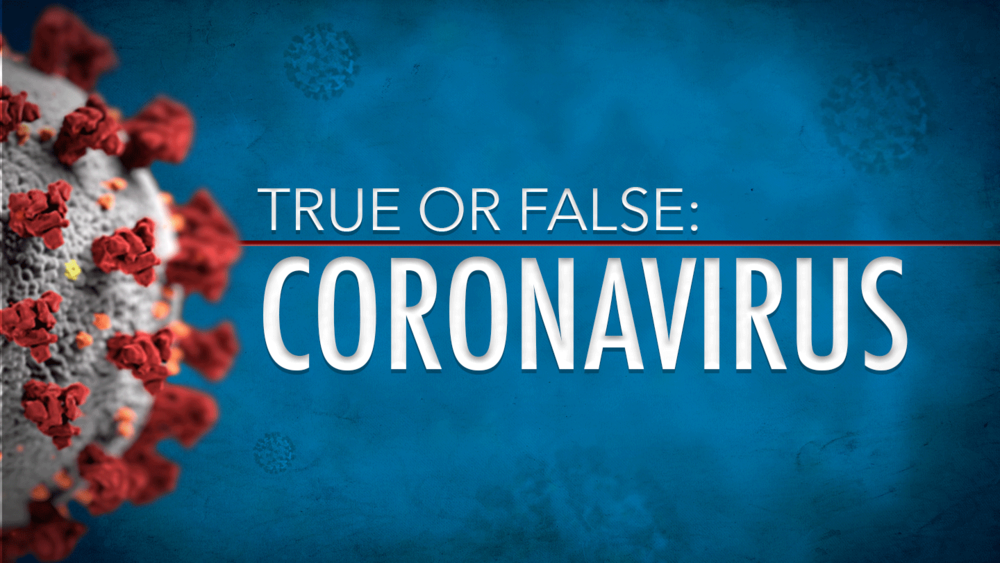Section Branding
Header Content
True Or False: Is Coronavirus Airborne?
Primary Content
There is still much that is unknown about the novel coronavirus that causes COVID-19. Scientists and researchers around the world are working to understand how it is spread, how to treat it and what we can all do to stay safe from it.
In these columns, Georgia Public Broadcasting attempts to dispel some of the most pervasive rumors and falsehoods that are spreading around the internet.
1. Since the coronavirus has a low pH level, eating high pH/alkaline foods like lemons, avocados and pineapples will help ward it off.
FALSE. The novel coronavirus does not have a pH level, which is found in water-based solutions, not in viruses. What’s more, eating high-pH foods will not change the pH level of the water, blood, or cells in your body.
2. A small drop of antibiotic ointment around your nose can keep you from catching the coronavirus.
FALSE. The theory behind this rumor is that the antibiotic ointment around your nose will kill off the virus and prevent you from inhaling it. However, antibiotics do not work on viruses. Antibiotics are great at fighting bacterial infections such as staph infections and streptococcus, but they are useless against a virus like COVID-19.
3. Israel has no deaths from the coronavirus because people there have been instructed to drink a combination of lemon juice and sodium bicarbonate.
FALSE. There are no juice/drink combinations that will help fight off the coronavirus. As of April 6, Israel had more than 8,000 cases and 50 deaths, according to Johns Hopkins University.
4. The coronavirus is airborne and can be passed just by talking to someone.
UNCLEAR. This is a very complicated question with no definitive answer at this time. When a sick person coughs or sneezes, large droplets fly through the air and can infect people nearby. These are called respiratory droplets, and that is how experts believe most people are getting sick with COVID-19. Due to the droplets' relatively large size, greater than 5 micrometers, they usually don't travel very far, and they don't stay in the air too long.
Scientists are conducting studies to find out if COVID-19 can be transmitted through smaller droplets of water expelled when we sneeze, talk or even breath, known as bioaerosols. There is some evidence this may be true, but the studies are not conclusive. For now, medical experts are still advising us to stay at least 6 feet apart from other individuals and practice self-isolation as the best means to avoid getting sick. The CDC has recommended cloth coverings as an additional, voluntary measure in public settings where other social distancing measures are difficult to maintain. N95 masks should be reserved for health care workers.
5. Dead bodies are the property of the state and you may not be allowed to bury your loved ones if they die from the coronavirus.
FALSE. A viral Facebook post claimed that New York state was not allowing families to claim the bodies of loved ones and that the dead were all being cremated. This is not true. While New York and other communities are advising against memorial/funeral services because it violates the ban on gatherings of multiple people, funerals that abide by the government’s social distancing guidelines are still allowed.
6. Students whose school year has been interrupted by the coronavirus are going to have to repeat this year of schooling.
FALSE. There was a viral April Fool’s Day prank that said students would not get credit for classes that were postponed by the outbreak. There has been no indication that school systems are contemplating something like this.
7. The proper way to wear a medical mask it to put the colored side on the outside if you are sick and the white side out if you’re not sick.
FALSE. The colored side of a mask should be worn on the outside — away from your face — whether you are healthy or not, according to medical officials. The colored side is waterproof, and the white side is absorbent so it can absorb your coughs. Social media rumors falsely claimed putting the absorbent white on the outside would help stop the germs from getting in. It is always best to follow the instructions provided from mask suppliers.
8. People with type A blood are more likely to catch the coronavirus while type O blood appears to ward off the disease.
Probably FALSE. There was a study of several thousand people in China that found slightly more cases of COVID-19 among people with type A blood and slightly less among people with type O. But medical experts stress that the study was not peer reviewed and the findings were only preliminary. What’s more, the number of type A and type O coronavirus victims was only a few percentage points off from what you would have expected to find in the general population.
References:
1. https://www.snopes.com/ap/2020/04/03/eating-alkaline-foods-will-not-kill-the-coronavirus/
2. https://apnews.com/13cae931dd47b912a5baff14de85b4e8
3. https://www.factcheck.org/2020/04/lemon-juice-tea-does-not-cure-covid-19-in-israel-or-anywhere-else/
4. https://www.sciencealert.com/is-coronavirus-spread-by-talking-and-breathing
https://www.cdc.gov/coronavirus/2019-ncov/prevent-getting-sick/diy-cloth-face-coverings.html
5. https://www.factcheck.org/2020/04/misinformation-on-covid-19-death-protocols-in-new-york/

